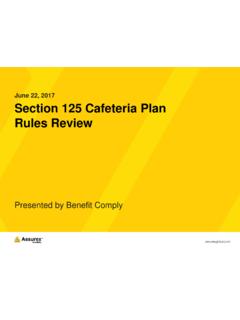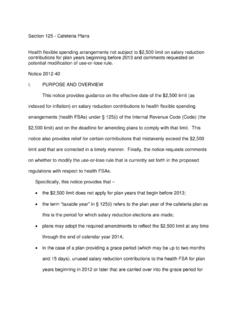Transcription of 24HourFlex Employer Discrimination Testing Guide Table …
1 24 HourFlex Employer Discrimination Testing Guide Table of Contents 1 Discrimination Testing Overview When to Perform Testing Highly Compensated Employee (HCE) Definition Key Employee (KEY) Definition Controlled and Affiliated Service Groups Correcting Test Failures Consequences of a Discriminatory Plan 2 Discrimination Testing Data 3 Definitions Highly Compensated Employee (HCE) Key Employee (KEY) Officer Spouse or Dependent More Than 5% Shareholder Revision History DateRevision Description 12/7/2015 Document creation 1 1 Discrimination Testing Overview A cafeteria plan (also referred to as a section 125 plan) is subject to certain nondiscrimination rules under Internal Revenue Code (IRC) section 125. Those rules prohibit a cafeteria plan from discriminating in favor of highly compensated individuals (HCIs) as to plan eligibility and benefits.
2 Many of the tests can be passed simply by properly designing the plan s eligibility provisions. Other tests need to be actually performed each year based upon participant data. When to Perform Testing As outlined under the 2007 proposed regulations, IRS Code section 125 Discrimination Testing should be performed as of the last day of the plan year and take into account all non excludable employees who were employed during the plan year. It is recommended that employers do one test within the first quarter of a plan year to determine whether additional steps must be taken before the end of the plan year so that the plan passes the non Discrimination tests and preserves the tax treatment for the key and highly compensated employees. A second and final test may then be conducted as of the last day of the plan year if there has been significant changes that could impact any of the tests.
3 Highly Compensated Employee (HCE) Definition A more detailed explanation of how the IRS defines HCEs can be found in the definitions section at the end of this Guide . The simplified definition is provided below: An employee is considered to be a Highly Compensated Employee (HCE) in 2016 if they meet one or more of the following criteria: a) An employee who in the preceding calendar year (2015) had compensation, from this Employer , greater than $120,000. Note also that the number of HCEs defined in (a) can be limited to the top 20% of the employees, when ranked by compensation however, this decision to adopt the top 20% rule must be consistently elected by the 401(k)/403(b) plan and the cafeteria plan. b) Someone who is a > 5% owner during the current or prior plan year. c) If also employed by the company, a spouse, parent, child or grandchild of a more than 5% owner.
4 Note that this attribution rule does not apply to HCEs that are highly compensated solely by virtue of their compensation. Key Employee (KEY) Definition A more detailed explanation of how the IRS defines Key Employees can be found in the definitions 2 section at the end of this Guide . The simplified definition is provided below: An employee is considered a Key Employee if in the prior year they met one or more of the following criteria: a) Officers with compensation greater than $170,000 (2015/16). Officers are limited to 50 employees (max) or, if less, the greater of three employees or 10% of all employees. b) More than 5% owners (including spouses, children, grandchildren, and parents of the owner). c) More than 1% owners with compensation over $150,000. Controlled and Affiliated Service Groups For plan Testing purposes, the IRS treats two or more employers as a single Employer if there is enough common ownership or a combination of joint ownership and common activity.
5 These rules are described in Code section 414(b), (c), and (m), which are directly incorporated into the cafeteria plan rules. The determination of whether or not there is a controlled group of companies is the responsibility of the Employer sponsoring the plan, along with their legal counsel, and is not a determination that is made by 24 HourFlex. If providing Testing data for a controlled group you must include employees from all companies within the controlled group in one Testing template. Correcting Test Failures If Testing is done early in the plan year, corrections can be made to employee salary reductions in order for the non Discrimination test(s) to pass. The methodology used to correct failures will be outlined in your plan document. Employee salary reductions cannot be recharacterized as after tax contributions after the end of the plan year.
6 If it is determined after the close of the plan year that a non Discrimination test has failed the applicable employees will be taxed in accordance with the test rules. Consequences of a Discriminatory Plan The cafeteria plan will continue to be a valid Code section 125 plan even if it is discriminatory. A qualified benefit (the cafeteria plan) does not cease to be a qualified benefit solely because it is taxable as a result of the violation of a nondiscrimination rule. A failure will not affect the favorable tax treatment conferred upon the non HCEs under the plan. If a cafeteria plan fails any of the nondiscrimination tests, then the HCEs and Key employees will lose the favorable tax treatment that the cafeteria plan otherwise provides and will have imputed income equal to the taxable benefit amount that they could have elected to receive for the plan year, even if they elected all qualified benefits.
7 So, in the event of a Testing failure, all HCEs and Key Employees that made pre tax salary deductions (that were included in the test) will be taxed on the entire amount of those salary deductions, and not just the portion of the pre tax salary deduction that caused the Testing failure. The Employer should treat the amount as taxable income for purposes of Form W 2 wage 3 reporting and for purposes of income tax, FICA and FUTA withholding. When applicable, DCAP Testing under Code section 129 is performed prior to Code section 125 cafeteria plan Testing . Unlike the cafeteria plan Testing , if there is a failure in DCAP Testing , HCEs are only taxed on the DCAP reimbursements they actually receive that would otherwise have been excluded from their taxable income. A DCAP Testing failure does not result in including the total amount of an HCE s pre tax DCAP salary reduction election in taxable income.
8 Although this can affect the Code section 125 Testing , DCAP failures are generally corrected before the end of the plan year, so would not usually be a concern. 4 2 Discrimination Testing Data You will need the following information to complete the 24 HourFlex Discrimination Testing Form . Ownership Information You need to identify any individuals with more than 5% ownership in your company who have dependent care elections. This number should include spouses, children, grandchildren, and parents of owners who are also employees in your company. Note : Government entities and some religious organizations will not have any owners. will need the total Dependent Care FSA contributions being deducted for individuals with more than 5% ownership in 2016. the total Dependent Care FSA elections in 2016 of all your individuals with more than 5% ownership (plus any dependent care elections for spouses, children, grandchildren, and parents of owners) to get this number.
9 Will need the total Dependent Care FSA contributions being deducted for everyone else in 2016. the total Dependent Care FSA elections in 2016 for non owners and owners with 5% or less ownership. Highly Compensated Employee (HCE) Information total number of HCEs who meet one or more of the following criteria: employee who in the preceding calendar year had compensation greater than $120,000. who is a > 5% owner during the current or prior plan year. shareholder owning > 5% of the voting power or value of stock of the Employer . also employed by the company, a spouse or dependent of one of the above. : This should be the total number of HCEs in your company regardless of how many are participating in a Dependent Care FSA. total number number of non HCEs in your company/organization. total annual Dependent Care elections for all your HCEs in 2016.
10 The total Dependent Care FSA elections in 2016 of all your HCEs to get this number. total annual Dependent Care elections for all your non HCEs in 2016. 5 the total Dependent Care FSA elections in 2016 of all your non HCEs to get this number. Key Employee Information You need to identify the total number of Key Employees who meet one or more of the following criteria: with compensation greater than $170,000. Officers are limited to 50 employees (max) or, if less, the greater of three employees or 10% of all employees. than 5% owners (including spouses, children, and parents of stockholder). than 1% owners with compensation over $150,000. Note : Government entities and some religious organizations may not have any Key Employees. will need the total benefit amount that will be deducted through your section 125 ( cafeteria ) Plan for all Key Employees in 2016.




